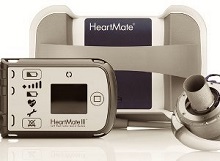 In a presentation at the annual meeting of the Heart Failure Association of the European Society of Cardiology, investigators from Brigham and Women's Hospital presented evidence that a next-generation cardiac pump device not only improves long-term outcomes but may also decrease cost of care over time for heart failure patients.
In a presentation at the annual meeting of the Heart Failure Association of the European Society of Cardiology, investigators from Brigham and Women's Hospital presented evidence that a next-generation cardiac pump device not only improves long-term outcomes but may also decrease cost of care over time for heart failure patients.
The research team analysed results from the MOMENTUM 3 trial, which compared two devices: The HeartMate II (current generation) and HeartMate 3 (a novel, centrifugal-flow pump), both manufactured by Abbott Inc, which sponsored the study.
"The HeartMate 3 left-ventricular assist device (LVAD) is a more forgiving pump in terms of clinical adverse events, and now we can confirm that its increased effectiveness is associated with decreased costs," said Dr Mandeep Mehra, executive director of the Centre for Advanced Heart Disease and medical director of the Heart & Vascular Centre at Brigham and Women's Hospital. "In medicine, most often, a therapy that demonstrates increased effectiveness usually comes at a higher price, and we are able to show that this new technology actually decreases costs to payers and patients over time."
Mehra and colleagues found that the newer device reduced costs due to re-hospitalisation by 51%, largely driven by a decrease in stroke and pump malfunction requiring re-operation due to pump thrombosis. Patients who received the HeartMate 3 experienced fewer hospitalisations and, on average, spent 8.3 fewer days in the hospital per year than those who received the HeartMate II. The authors note that it may be possible to further reduce costs by decreasing outlier complications and reducing hospital length of stay and decrease early complications by improving patient selection criteria and considering this therapy before patients get too sick.
In April, Abbott Inc issued a field safety notice regarding HeartMate 3 outflow graft twist complications with an incidence rate of 0.72%. The US Food and Drug Administration (FDA) issued a Class I recall but did not recommend the return of LVADs or avoidance of use in new patients. The current study re-reviewed 20 hospitalisations (five in the HeartMate 3 and 15 in the HeartMate II populations) and in a conservative analysis, classified them as being device-related for the purposes of this analysis. Nonetheless, the data still demonstrated a reduction in re-hospitalisation related hospital days and significant cost savings for the HeartMate 3 compared to the HeartMate II.
Abstract
Background: MOMENTUM 3 compares the centrifugal HeartMate 3 (HM3) to the axial HeartMate II (HMII) continuous-flow Left Ventricular Assist System (LVAS) in patients with advanced heart failure, irrespective of the intended goal of therapy. The trial's 2-year clinical outcome (n=366), demonstrated superiority of the HM3 for the primary endpoint (survival free of a disabling stroke or reoperation to replace or remove a malfunctioning pump). This analysis evaluates health resource use and cost implications of the observed differences between the two devices while patients were enrolled in the trial.
Methods: We analyzed all hospitalizations and their associated costs, occurring after discharge from the implant hospitalization, until censoring (study withdrawal, heart transplantation, pump exchange with a non-study device or death). Each adjudicated episode of hospital-based care was used to calculate costs (device attributable and non-device attributable event costs), estimated using trial data and payer administrative claims databases. Cost savings stratified by subgroups (study outcome (transplant, death or ongoing on device), intended goal of therapy, type of insurance, or gender) were also assessed.
Results: In 366 randomized patients, 361 comprised the as-treated group (189 the HM3 and 172 the HMII), of whom 337 (177 the HM3 and 160 the HMII) were successfully discharged following implantation. The HM3 arm experienced fewer total hospitalizations per patient year (HM3: 2.1±0.2 versus HMII: 2.7±0.2, p=0.015) and 8.3 fewer hospital days per-patient-year on average (HM3: 17.1 days versus HMII: 25.5 days, p =0.003). These differences were driven by patients hospitalized for suspected pump thrombosis (HM3: 0.6% versus HMII: 12.5%; p<0.001) and stroke (HM3: 2.8% versus HMII: 11.3%; p=0.002). Controlled for time spent in the study (average cumulative cost per patient-year), post-discharge HM3 arm costs were 51% lower than with the HMII (HM3: $37,685±4,251 versus HMII: $76,599±11,889, p <0.001) and similar in either bridge to transplant or destination therapy intent.
Conclusions: In this 2-year outcome economic analysis of the MOMENTUM 3 trial, the HM3 demonstrated a reduction in re-hospitalizations, hospital days spent during rehospitalizations, and a significant cost saving following discharge when compared with the HMII LVAS, irrespective of the intended goal of therapy.
Authors
Mandeep R Mehra, Christopher Salerno, Joseph C Cleveland, Sean Pinney, Melana Yuzefpolskaya, Carmelo A Milano, Akinobu Itoh, Daniel J Goldstein, Nir Uriel, Sanjeev Gulati, Francis D Pagani, Ranjit John, Robert M Adamson, Roberta C Bogaev, Vinay Thohan, Joyce Chuang, Poornima Sood, Scott Goates, Scott C Silvestry
[link url="https://www.sciencedaily.com/releases/2018/06/180604155448.htm"]Brigham and Women’s Hospital material[/link]
[link url="http://circ.ahajournals.org/content/early/2018/05/25/CIRCULATIONAHA.118.035722"]Circulation abstract[/link]
